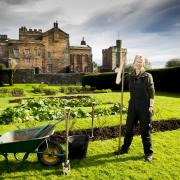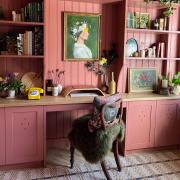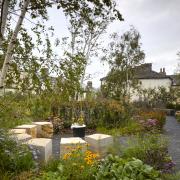On the cover of Rachael Matthews’ new book the author is laid out on the ground flattened by a giant ball of fabric. Yes, that is her under there, run over Roald Dahl-style by a boulder of boucle. But like Roald Dahl, there is a serious message behind the comedy.
The giant ball represents the over-production, over-purchasing and accumulation of stuff, in this case clothing, and the eventual outcome when it becomes waste.
Rachael has made “quite a few” oversize boulders of cloth. “I am a Lake District walker and I love mountains and boulders, I love the scale of things, and this is a way to show how much waste there is to deal with,” she says. “But I also love giving rocks hugs so making things that you can hug and fall over like a boulder seemed obvious to me.”

A lecturer in textiles at Central St Martins, in London, specialising in knit and colour, and a teacher at the Victoria and Albert Museum, Rachael’s childhood in the Lakes did much to inform her future direction. Growing up in a creative family with grandparents and great grandparents from ‘waste not, want not’ generations introduced her specifically to how things made from cloth were valued.
She is from the famous Pattinson family of builders, whose mark is left on many South Lakes’ homes. Her grandfather was the builder and boat collector George Pattinson, on whose collection the Windermere Steamboat Museum (now Windermere Jetty Museum) was founded. But it was her grandmothers’ stores of fabric that inspired the most.
“My grandparents saved everything, whether it was windows that would be taken out of one place and put in another or the airing cupboards of fabrics I grew up with. There was fabric going back to my great grandparents piled up in cupboards; it was all saved and reused.

“Moving into adult life, it began to really interest me where all our clothes and fabrics end up and the difference between then and now and how disposable clothes have become.”
Having gone to St Anne’s School, in Windermere, Rachael moved to London to study textiles at Central St Martins. In the city, she has witnessed similar accumulations of fabric, only this time it is on the streets around her home. “I don’t think it happens in Cumbria, but in London we often have huge piles of clothing, bedding and other materials in the street; it comes from the high turnover of rental properties and fast fashion.
“The piles of discarded textiles that emerge from our homes, on our streets and all over the globe, are testament to the fact that many of us have been living in an age of abundance and affluence.” Her response was, inevitably, a creative one, with a healthy dose of irreverence thrown in. She has always knitted and as well as teaching knit from 2007-2015 she successfully ran a yarn shop in London focusing on ethically produced products, including connecting to the Wool Clip in Caldbeck and introducing Herdwick yarn to city customers.
But it was her lockdown walks past piles of textiles that triggered radical action. In her new book, Rag Manifesto: making, folklore and community, she reveals: “Touching anything alien during a pandemic was considered dangerous, but as I was masked and gloved and in possession of a wheelbarrow, I took action. I pushed the first load home and, after running it through a 90-degree wash cycle, I was astonished to find full spectrums of colour emerging from my washing machine. With the charity shop closed indefinitely, I chopped the garments into yarn and re-learned weaving.”

Her lockdown experimentation gained her a placement at The Experimental Weave Lab, hosted by two art college colleagues, at the Clothworker’s Company in the City of London. Sharing a studio with other experimental weavers and learning about many ancient ways of making things, a new world started to appear, with an endless source of modern materials to hack.
Identifying that rag is a rich resource and in the past was a valuable commodity you could sell, Rachael also came to realise how it had become wrongly classed as taboo material. Gathering rag and turning it into yarn was rich with the possibility of making things and she began to look at how people could reconsider the value of waste.
“In the past people were making rag rugs, it was fine art, but that got lost as it became taboo and classed as dirty or women’s work,” she says. “There was a patriarchy in the fine art world which split textiles away from oil painting a long time ago and the textile work, which was mostly done by women, was lessened.”
European modernist painters, such as Ben Nicholson and his first wife Winifred Nicholson (a granddaughter of George Howard, the 9th Earl of Carlisle, who had a house near Brampton and died in Cumbria) became interested in rag rug making in the 1920s. Pablo Picasso used found materials and recognised that ‘primitive’ art was highly skilled. “The art world missed a trick in not accepting these painterly rag works as true art and many have been lost,” says Rachael. She adds: “Recycling material has been normal for 8,000 years in India, but here the culture of rag as valuable has changed.

Instead, new stuff is sold to us in a way that makes us feel we must need it to make us feel better.
“So as soon as we see deodorant stains or spill a bit of curry on a white t-shirt we think it’s ruined because it’s suddenly not glamorous any more. We don’t see it as cotton that’s a beautiful material that used a lot of the world’s resources to be made and can be over dyed with natural colours.
“Old pants contain elastic that is still really good material that can be spun into cords, used as a highlight in a weave. Once things are cut up into their components within them are things that can be reused.” Rag Manifesto is, therefore, a call to arms for “the overlooked fabric detritus in our world”.
Described as “a big thinker”, Rachael gives us permission to cut up old fabrics. In the book she offers a support structure for decision making and even a chart explaining when to chop something up and how it can be recycled, whether it be a found item or a misguided purchase.

But is about more than just finding new ways with old fabric. Destroying a garment to reuse it is liberating, and she shows how such action can develop community as well as self-esteem.
“Coming out of Covid there was a lot of depression and people wanting company but they didn’t necessarily feel they had design skills to share,” says Rachael.
She started demonstrating the weaving skills she had developed online and, strengthened by a shared concern about the textile waste on the streets, founded Rag School, an online studio to rediscover the lost ways of making things.
“Diane Haigh, a professor of architecture at Cambridge University who is from Kendal, started a series of online studios so I suggested a virtual rag studio.
“A diverse group came together from all over the world. We talked about what we have in our family archives and it became a space for sharing indigenous skills, experimenting, having a laugh and showing off high-quality work, demonstrating that banked knowledge gushes out if you ask it to.”

The online project led to a real-life Rag School with East London Textiles Arts, working with a diverse community group in Newham.
Rachael’s practice deepened with new knowledge about how people can design together without the training of art school and how histories emerged amid the ripping and the sewing.
“Gradually I was able to put different design challenges in. The idea of people coming together and taking over this material and giving them clues to what they can make collectively was empowering. There is lots of humour and chat that relates to their history, geography, and stories.”
It showed how diverse communities everywhere could re-learn how to process textile waste in beautiful ways, caring for each other along the way. “The transformation of waste has been a valuable remedy in recovering from the collective trauma of the pandemic: ripping is thrilling, storytelling cathartic and the craft work a great place of focus and thought.
“I had taken the concept into universities as well, so for me it combined that lofty thinking with real, on-the-streets work as well. We make professional art works which tell stories about global and local issues, whilst enhancing the wellbeing of all participants and our local environment.”
Rachael now runs a weekly community group for a diverse community of women at Newham, in east London.
From the removal of waste from the streets to communities connecting to mental health benefits, there is profit in reusing rags. And the scale and impact of the textile industry on the environment is cause for concern at the highest levels with the EU setting out why it wants to reduce waste and increase the life cycle and recycling of textiles towards achieving a circular economy by 2050.
Like Rachael says, it begins with a single cotton t-shirt which, according to the EU uses 2,700 litres of fresh water in its production, enough to meet one person’s drinking needs for two and a half years.

The textile sector was the third biggest source of water degradation and land use globally in 2020 and textile production is estimated to be responsible for about 20 per cent of global clean water pollution from dyeing and finishing products. The fashion industry is also estimated to be responsible for ten per cent of global carbon emissions, more than international flights and maritime shipping combined.
When it comes to waste clothing, only one per cent in Europe is recycled into new clothes. According to the EU, 87 per cent of used clothing is incinerated or goes into landfill.
With plans to return to Cumbria, Rachael says she would love to bring her ‘craftivism’ here. “With Rag School I don’t feel it should be me telling people how to use rags and how things should be made. It has to be fun and jolly and give people agency. I want to get the materials out and see what happens to it in this era; to present lots of ideas, not necessarily to tell people how to do it but to give them the tools to do it themselves.
“I have taught in universities for quite a long time where there is a very structured syllabus, but I am Cumbrian so I have always loved a bit of anarchy.”
Hers is a manifesto with creativity at its heart and playfully expressed. She adds: “It feels like this resurgence is like a murmuration. Different types of rag work is taking off for different reasons and people find different ways to express themselves.
“My intention is for Rag School to be introduced to any community, offering empowerment through the transformation of materials, changing our relationship to commercial fashion and textiles.”
Rag Manifesto: making, folklore and community by Rachael Matthews, (£21, published by Quick Thorn)



























